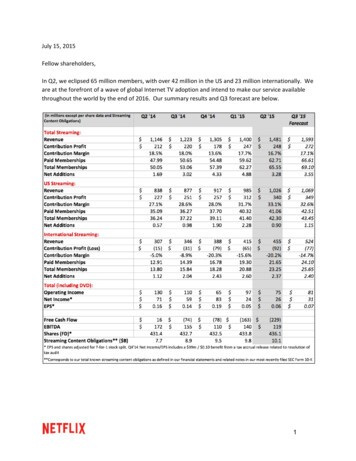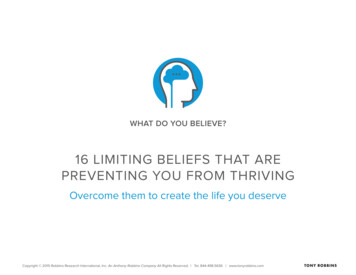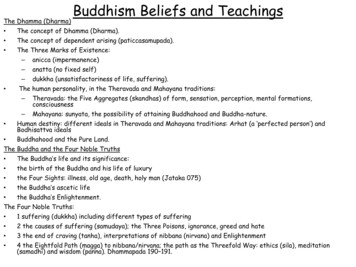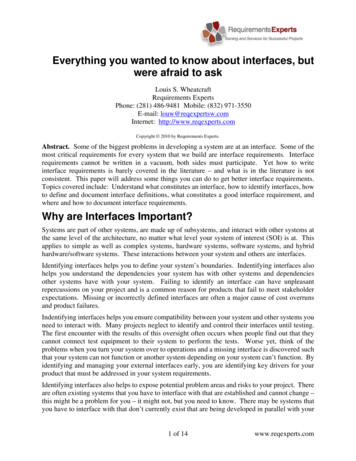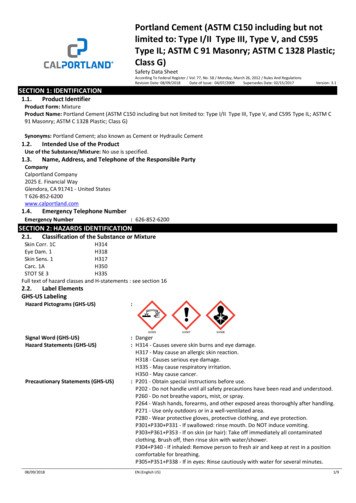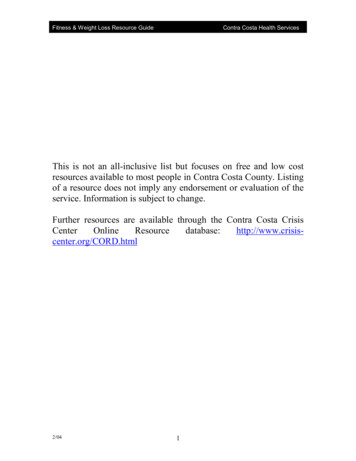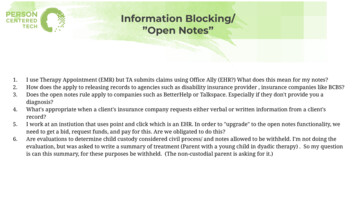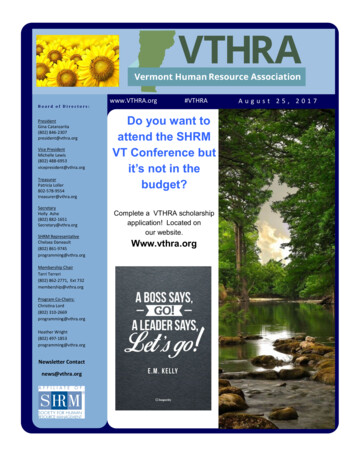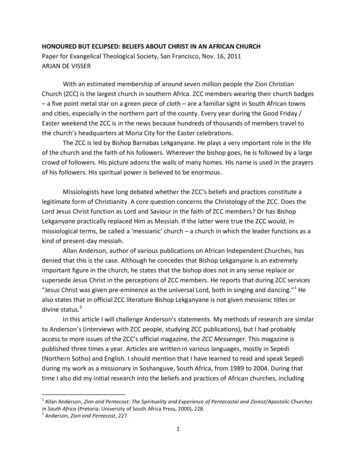
Transcription
HONOURED BUT ECLIPSED: BELIEFS ABOUT CHRIST IN AN AFRICAN CHURCHPaper for Evangelical Theological Society, San Francisco, Nov. 16, 2011ARJAN DE VISSERWith an estimated membership of around seven million people the Zion ChristianChurch (ZCC) is the largest church in southern Africa. ZCC members wearing their church badges– a five point metal star on a green piece of cloth – are a familiar sight in South African townsand cities, especially in the northern part of the county. Every year during the Good Friday /Easter weekend the ZCC is in the news because hundreds of thousands of members travel tothe church’s headquarters at Moria City for the Easter celebrations.The ZCC is led by Bishop Barnabas Lekganyane. He plays a very important role in the lifeof the church and the faith of his followers. Wherever the bishop goes, he is followed by a largecrowd of followers. His picture adorns the walls of many homes. His name is used in the prayersof his followers. His spiritual power is believed to be enormous.Missiologists have long debated whether the ZCC’s beliefs and practices constitute alegitimate form of Christianity. A core question concerns the Christology of the ZCC. Does theLord Jesus Christ function as Lord and Saviour in the faith of ZCC members? Or has BishopLekganyane practically replaced Him as Messiah. If the latter were true the ZCC would, inmissiological terms, be called a ‘messianic’ church – a church in which the leader functions as akind of present-day messiah.Allan Anderson, author of various publications on African Independent Churches, hasdenied that this is the case. Although he concedes that Bishop Lekganyane is an extremelyimportant figure in the church, he states that the bishop does not in any sense replace orsupersede Jesus Christ in the perceptions of ZCC members. He reports that during ZCC services“Jesus Christ was given pre-eminence as the universal Lord, both in singing and dancing.”1 Healso states that in official ZCC literature Bishop Lekganyane is not given messianic titles ordivine status.2In this article I will challenge Anderson’s statements. My methods of research are similarto Anderson’s (interviews with ZCC people, studying ZCC publications), but I had probablyaccess to more issues of the ZCC’s official magazine, the ZCC Messenger. This magazine ispublished three times a year. Articles are written in various languages, mostly in Sepedi(Northern Sotho) and English. I should mention that I have learned to read and speak Sepediduring my work as a missionary in Soshanguve, South Africa, from 1989 to 2004. During thattime I also did my initial research into the beliefs and practices of African churches, including1Allan Anderson, Zion and Pentecost: The Spirituality and Experience of Pentecostal and Zionist/Apostolic Churchesin South Africa (Pretoria: University of South Africa Press, 2000), 228.2Anderson, Zion and Pentecost, 227.1
those of the ZCC.3 The present article uses some of that initial research but has been updatedthrough analysis of articles that have been published in The ZCC Messenger during the lastdecade.4THE ZION CHRISTIAN CHURCH: BACKGROUND INFORMATIONIn 2010 the ZCC celebrated its 100th anniversary. Official documents of the church claimthat the church was founded in 1910 by Rev. Engenas Lekganyane, the grandfather of thecurrent bishop.5 It is believed that in that year Lekganyane had a spiritual experience which heinterpreted as a divine call.6 Afterwards he functioned as an evangelist, minister and bishop invarious churches. In 1924 Lekganyane seceded and formed his own church, the Zion ChristianChurch.7The name ‘Zion’ needs some explanation. It reflects a connection to Zion City, Illinois,the place where John Alexander Dowie reigned as apostle over a movement called the ChristianCatholic Church in Zion. Dowie’s movement came out of the North American Holinessmovement and emphasized divine healing and baptism of adult believers by triple immersion.In 1904 one of Dowie’s associates, Daniel Bryant, arrived in South Africa. He baptized hundredsof converts and had a significant influence on leaders of young African churches. Many of thesechurches added the designation ‘Zion’ to their names and continued to focus on healing rituals.Another significant influence on the early African churches was the Pentecostalmovement. In 1908, very soon after the beginning of the Azusa Street Revival in Los Angeles,Pentecostal missionaries arrived in South Africa. They introduced the practices of speaking intongues and prophesying. These practices have been retained in modified form in AfricanZionist churches. With the passing of time various African churches developed and moved inslightly different directions. Opinions are divided on the question whether these churches maybe called Pentecostal churches.3See A.J. de Visser, Kyrios and Morena: The Lordship of Christ and African Township Christianity (Th.D. dissertation,University of Potchefstroom, 2001).4Copies of The ZCC Messenger are not for sale and are not made available to outsiders. Through informal contactsin Soshanguve I have been able to gather and collect 36 issues of the magazine (close to 50 % of the issuespublished so far).5The ZCC Messenger, # 76 (Easter 2010), 5.6The ZCC Family Bible (published by the ZCC in 1995) has a historical section which reports: “In 1910, the founderof ZCC had a vision and calling. He then went to Rev. Mahlangu of Zion Apostolic C hurch. In 1912 Rev. Engenasbecame a member of Zion Apostolic Church.”7This must be the reason that 1924 is mentioned as the founding year of the ZCC as well, e.g. on pictures of bishopEdward Lekganyane (father of the current bishop) which are still hanging on the walls of many older ZCC members.The text under the picture says: “With compliments from Zion Christian Church. Founded in 1924 by Rev. E.B.Lekganyane. Successor: E.E. Lekganyane.” Overviews of the history of the ZCC are offered in various sources, e.g.E.K. Lukhaimane, “The Zion Christian Church of Ignatius (Engenas) Lekganyane, 1924-1948: an African experimentwith Christianity” (M.A. thesis, University of the North, Pietersburg, 1980), and Allan Anderson, Zion and Pentecost,68-72.2
Under Engenas Lekganyane’s leadership the Zion Christian Church grew at an amazingpace. The main attraction of Lekganyane’s ministry was the miracles he performed, mostlyhealing miracles. The centenary issue of The ZCC Messenger (Easter 2010) contains a number ofreports by elderly members of the ZCC who remember miracles that were performed byLekganyane in the 1940s. Most of these miracles were healings but there are a few reports ofrain-making and raising dead animals back to life as well. An example:“One day bishop Engenas Lekganyane did a miracle in the presence of Mr. Ngobeza andhis friends. They had found a dead dove, and it was confirmed that it was really dead. Engenastold them to bring the dove to him so that he could bring it back to life. He prayed for the dove,it came back to life and sat down in the top of a tree. Engenas preached to them about thethings of heaven.”8Engenas Lekganyane died in 1948. A leadership struggle between his two sons Edwardand Joseph resulted in the church being split in two parts. Edward’s church became the largestand is today called the Zion Christian Church. Under Edward’s leadership the church continuedto grow remarkably.9 This continued after Edward’s death (1967) when his son Barnabas (alsocalled Ramarumo) took over. In 1995 the ZCC claimed that its membership stood at 7 million,spread over various countries in southern Africa.10 According to the South African populationcensus of 2001 Zionist Christian churches had just under four million members.11 Adding to thisthe membership in other countries in southern Africa and ten more years of growth, the totalmembership of the ZCC today could indeed be around seven million.12PRACTICES AND BELIEFSZCC members are easily recognizable in South African society. During the week theywear the church badge: a silver star on a green piece of cloth. On Sundays they wear a churchuniform. The women wear green, yellow, or blue, depending on their role in church activities(women’s prayer group, choir). Many men wear a green suit. Others wear a khaki uniform.ZCC members typically gather for worship on Sunday afternoons. I have attendedseveral ZCC worship services personally. It was always fascinating experience. A beautiful8The ZCC Messenger, # 76 (Easter 2010), 8. Translated from Sepedi.Numbers vary considerably. The ZCC Family Bible says that by 1955 the ZCC had a membership of 20,000.Anderson says that by 1954 the membership was already some 80,000 (Zion and Pentecost, 71).10ZCC Family Bible (1995), historical section.11Statistics South Africa: Census 2001 report (p. 25), .pdf(accessed Sept. 5, 2011).12An indication of the ZCC’s growth outside South Africa is the opening of a new church building in Harare,Zimbabwe, by bishop Lekganyane, November 4-6, 2011 (http://relzim.org/news/3186; accessed Nov. 12, 2011)93
aspect of ZCC worship is the singing, with several choirs performing both before and during theservice. The preaching I have heard was usually disappointing: Several lay-ministers wouldpreach short sermons and they would usually twist their text passage in such a way that itbecame a doxology on the power of the ZCC and its bishop, Barnabas Lekganyane. Anotheraspect of ZCC worship is the activity of the mabone (lit. lights), the church prophets. While theministers are preaching, these ‘seers’ walk among the crowd and call certain people aside sothat they can give them their personal ‘revelation.’In terms of sacraments, the ZCC practices adult baptism. Baptisms are typicallyperformed in a river. The Lord’s Supper is largely ignored. One of the reasons may be that theZCC prohibits the use of alcohol.Healing from sickness is very important to the ZCC. It is believed that the prophets of thechurch receive revelations about illnesses and healing, and that the ministers of the church usethe power of the Holy Spirit to perform healings. Members who struggle with illness need to goand see the minister at church. They will be prayed for and receive specific healing instructionsfrom the minister. They must carry out these instructions exactly as they have been told. Forexample, members may be given ‘holy water’ (meetse a makgethwa), take it home and sprinkleit as a ritual of purification or protection. Or they may have to drink it or use it for washing.Alternatively, members may be told to drink a certain kind of coffee or tea.In an article entitled ‘No illness is too difficult for the Zion Christian Church’13 Rev. J.R.L.Rafapa refers to the command of Christ to his disciples that they should heal the sick, raise thedead, and cleanse those who have leprosy (with a reference to Mat. 10:8). Just like the discipleswere called to obey the word of Christ and heal the sick, so ZCC ministers are called to bediligent in giving people their healing instructions because, Rev. Rafapa argues, “this is what theministry of the ZCC is all about.” The author goes on to say that faithful ZCC ministers “cook orprepare tea, coffee, cocoa, inhalation, or Hamburg tea, as the instruction directs for eachindividual.”14The church prophets or seers are believed to receive revelations from the Holy Spiritand/or the ancestor spirits which enable them to predict events, know the cause of illnesses,and prescribe instructions for healing.15 During the course of my own field research I attended aZCC worship service and was called aside by one of the prophets of the church to receive ‘myrevelation.’ The prophet told me that during the past week there had been contact between myancestor spirits and those of bishop Lekganyane, so he knew that I was coming. He also told methat my church would experience significant growth if I asked the ministers of the ZCC to pray13The ZCC Messenger, # 57 (December 2003), 39-42. Original title in Sepedi: ‘Ga go na bolwetsi bjo bo palelagoditaelo tsa Zion Christian Church.’14The ZCC Messenger, # 57 (December 2003), 42. The word ‘inhalation’ (Sepedi: mogabolo) refers to the inhalationof mixed spices (chilli etc.).15M. West, “People of the Spirit: the Charismatic Movement among African Independent Churches.” Journal ofTheology for Southern Africa No. 7 (1974), 23-29.4
for me. It had also had been revealed to him, he said, that I was suffering from pain somewherein my body. I needed to go to a natural well, draw water from it and take it to a ZCC minister sothat he could pray over it. This would restore my health.16As illustrated by this event, ancestor spirits still play an important role in the faith life ofmany ZCC members,17 even though ancestor veneration is not officially encouraged. The ZCCMessenger is often critical about the practice. Jabulani Calvin Makhubela writes: “You cannotfollow the servant of Christ, Ramarumo, if you have not thrown and/or burnt your traditionalbones and muti, still stealing, venerating ancestors, consulting traditional headers and diagelosurgeons. We need to leave everything, which was of help to us, and follow Jesus.” 18 Yet,information gathered in personal conversations indicates that ancestor veneration is definitelyfound at the grass roots level. During my field research in Soshanguve I was more than oncetold that ZCC members wish each other well by saying “may your ancestors and Lekganyane’sancestors meet and work together.”19 I have also personally spoken to ZCC members whoinsisted that Lekganyane’s ancestor spirits do communicate with ancestor spirits of otherpeople, and that this is the reason why people find help in the ZCC.The ZCC is a church with many rules and regulations. As much as possible such rules arebased on Biblical commands, often from the Old Testament. A few examples: It is forbidden toeat pork (Deut 14:8), it is forbidden to drink alcohol (Lev 10:8-11), it is forbidden to eat mopaniworms (Deut 14:19). Polygamy is allowed (Isaiah 4:1). The custom of wearing church badges isbased on the OT command to wear tassles (Num 15:37-40).20Three times a year ZCC members are expected to travel to the headquarters of thechurch at Moria City, 50 km’s east of the town of Polokwane. This custom is based on Deut.16:16: “Three times a year all your men must appear before the Lord your God at the place hewill choose.”21 As a result, ZCC men and women come to the bishop’s headquarters three timesa year: at Christmas, at Good Friday/Easter, and the Pulo ya Ngwaga (opening of the year)festival in September. The largest gathering is the annual Good Friday/Easter celebration whenhundreds of thousands of ZCC members make the journey to Moria City.The highlight of every festival at Moria is the appearance of Bishop Lekganyane.Anderson describes the event as follows: “The appearance of the bishop at the annualconferences is to many ZCC members the climax of the weekend’s festivities, and all the faithfullong to be a close to him as is humanly possible to receive some of his power. At Easter 1992 I16This was at the ZCC church at Soshanguve, north of Pretoria, in 1997. For a full account of this experience, seeA.J. de Visser, Kyrios and Morena, 90-93.17See also Anderson, Zion and Pentecost, 180-184.18ZCC Messenger # 55 (Easter 2003), 31-32.19In Sepedi: “Badimo ba gago le badimo ba Lekganyane ba kopane ba be ntho e tee.”20The ZCC Messenger # 23 (September 1992), 26.21The ZCC Messenger # 23 (September 1992), 26.5
witnessed the impressive sight of Bishop Barnabas Lekganyane marching at the head of hisbrass band, swinging his bishop’s mitre. It was obviously the high point of the proceedings thatall had been waiting for, and many were overcome with the emotion of the occasion.”22In the minds of ZCC people present day Moria City is comparable to Jerusalem of old.The joy that the ZCC people experience when they gather at Moria is equivalent to the joyJewish people experienced when they gathered in the Holy City. Bishop Lekganyane reinforcesthis understanding in his sermons. In a sermon on Psalm 122, preached during the 2009 Easterfestival, he drew a parallel between the words of the Psalmist “Our feet are standing in yourgates, O Jerusalem,” and the experience of ZCC members meeting at Moria City. The words ofthe Psalmist “Jerusalem is built like a city that is closely compacted together” are given thefollowing application: “I liken these closely congested houses to the buses, cars and tents whichare here at Moria to worship and praise the name of our Lord Jesus Christ.” 23BELIEFS REGARDING CHRISTWith respect to the ZCC’s doctrinal beliefs it is hard to find official statements. I am notaware of the existence of a publication or confession in which the ZCC sets forth its doctrinalbeliefs in a systematic way. Interestingly, many years ago the ZCC published a translation ofLuther’s Small Catechism with some additions, but it appears that this document does notfunction in ZCC beliefs anymore.24 It is not referred to in the church magazine.Current doctrinal beliefs of the ZCC can be gleaned from sermons by Bishop Lekganyaneand articles written by various authors, as published in The ZCC Messenger. Many sermons andspeeches of Bishop Lekganyane are exhortations to his followers to live morally upright lives.He often expresses concern about evils in the society such as the rampant crime, the decline ofgood neighbourliness, and the continuing threat of racism and xenophobia.25 He often warnsagainst indulging in alcohol, drugs and immorality,26 and he regularly speaks out against samesex marriage, abortion, and the abuse of women and children.27 Sometimes the bishopdiscusses the economical situation of the time and even admonishes the politicians about their22Anderson, Zion and Pentecost, 228.The ZCC Messenger # 74 (September 2009), 12.24The title of this publication was Katekesima e nyane (Small Catechism). It contains the main parts of Luther’sSmall Catechism, translated in Sepedi, with additions regarding forbidden foods and drinks (pork, alcohol). Thereason that Lutheran material was used must be that the Lutheran mission was historically prominent amongSepedi speakers. Among the older generation of ZCC members many came out of the Lutheran church.25Message delivered Sept. 9, 2009, at Moria City, The ZCC Messenger # 75 (Dec. 2009), 5.26ZCC Messenger # 75 (Dec. 2009), 6.27The ZCC Messenger # 75 (Dec. 2009), 13236
behaviour. An example: “The noise that we hear and mudslinging and character assassinationshould come to a stop. This country deserves better.”28While Bishop Lekganyane’s sermons cannot be characterized as expository sermons andthe theological content is mostly shallow, he will occasionally speak highly of the work of theLord Jesus Christ. Having compared sermons from the 1980s and 1990s with sermons preachedduring the last decade, it is my impression that he is doing so more often. During his Eastersermon in 2009 the bishop spoke about justice and peace and stated that “Peace and Justicewere brought to us by the coming of the Messiah when He died for our sins on the cross.” 29 Thebishop then proceeded to explain the importance of the cross of Christ by reflecting on the factthat the cross has a vertical beam (pointing to peace with God) and a horizontal beam (pointingto peaceful relationships between humans). The application was that it is impossible to havepeace with God if you don’t have peace with your neighbours or relatives. The bishopcontinued: “I am hopeful that we have come here to worship the name of our Lord Jesus Christand to give thanks to the gifts that He has given to us, to ask for his blessings and increasedlifespan because the works of God are clearly visible.”30As for other articles published in the ZCC’s official magazine, articles that discuss theperson and work of Jesus Christ are rare but there are notable exceptions. In an article entitled“This s
THE ZION CHRISTIAN CHURCH: BACKGROUND INFORMATION In 2010 the ZCC celebrated its 100th anniversary. Official documents of the church claim . University of the North, Pietersburg, 1980), and Allan Anderson, Zion and Pentecost, 68-72. 3 Under Engenas Lekganyanes leadership the
